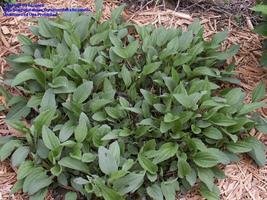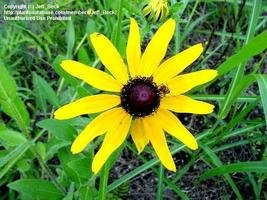





I used to be innocent. I used to be trusting. When a neighbor said, "Would you like some of these black-eyed Susans?" I never hesitated to plant them in my own garden. Now, being wiser and more disillusioned, I understand the universal truth: that when a gardener has large amounts of a plant she is eager to give away, there is usually a reason.
There are several different flowers often called black-eyed Susan, but I have figured out that mine are probably the popular variety Rudbeckia fulgida 'Goldsturm'. It is sometimes also called the orange coneflower (although many people consider the only true coneflowers to be the members of the related genus Echinacea, and the cultivar 'Goldsturm' isn't orange. The "true" black-eyed Susan is the closely related Rudbeckia hirta, which is also sometimes called the ox-eye daisy; though it is not, of course, a daisy.
The rudbeckias and echinaceas are both perennial members of the aster family, which also includes chrysanthemums, daisies, sunflowers, and of course true asters. While it may be difficult to tell the rudbeckia species apart by their flowers, the form of the leaves is different. R. fulgida (left) has long, teardrop-shaped toothed leaves, dark green in color, sometimes tinged purple; the leaves of R. hirta (right) are paler in color, more narrow, less toothy, and leaves and stems are hairy.


Because the Rudbeckias are native plants of North America, some people will say I can not properly call them "invasive" here. Fine, but they certainly do spread! While they seed themselves, they spread more readily by runners that sneak along just below the surface of the earth, popping up new plants every couple of inches. These new plants are insidiously tiny above ground, hard to spot and harmless-looking at first. But they are rooted quite tenaciously and do not willingly let go of the earth. Before long, each one is firmly established and sending out new runners of its own.
Of course the defenders of rudbeckia would say that you want a desirable plant to spread, and, to an extent, this is true. When I accepted these plants from my friendly neighbor, I was happy to find a plant that would flower later in the year. The section of the garden where I put them already had painted daisies, which make a fine show in May and June but die back in the mid-summer heat. Rudbeckia follows them quite effectively. The bright gold flowers are attractive and stand for weeks, providing bloom for the rest of the year, into fall.
If only they would stay where I put them, the way the painted daisies do! If only they wouldn't insinuate themselves into the roots of the other plants! If only they were more easily pulled out when they do! But no, so there you can find me on my knees with my garden paring knife, carefully dissecting out the upstart new sprouts of rudbeckia from the rhizomes of the Zebra Iris. It is at such times when I contemplate the fact that there is far more than one flower calling itself the Black Eyed Susan, and that somewhere is a variety that is just as attractive, blooms just as long, and doesn't spread at quite such a rampant rate. If only I had taken the trouble to find it, instead of taking the neighbor's unwanted plants off her hands.
The next time some cheerful neighbor comes offering me excess plants, I hope I will remember that there is probably a reason why she wants to get rid of them.
(Editor's Note: This article was originally published on April 29, 2008. Your comments are welcome, but please be aware that authors of previously published articles may not be able to promptly respond to new questions or comments.)
Copyright © www.100flowers.win Botanic Garden All Rights Reserved